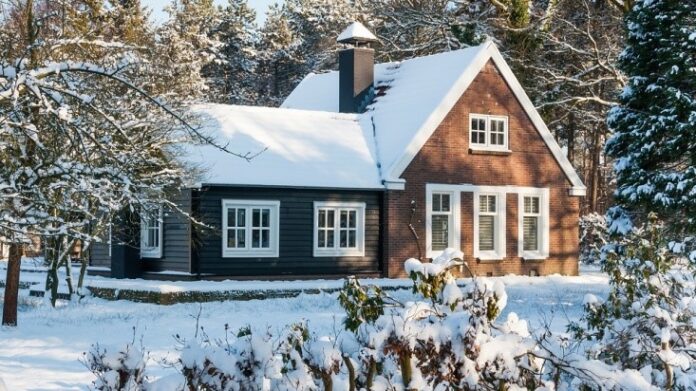Winter can cause a lot of damage to the exterior of your home if you aren’t prepared.
From unnecessary leaks to broken pipes, your home could be vulnerable to various damages with the drastic changes in weather that winter brings.
These five steps will not only help protect the value of your home but it will give you the comfort and peace of mind knowing you can relax inside during the cold.
Here Are The Top 5 Ways You Can Protect Your Home This Winter And Avoid Costly Repairs
1. Dealing with The Roof
Making sure your roof is secure heading into winter is crucial, as you don’t want any leaks causing pricy repairs.
Prepare in the fall by getting a roof inspection done. A roofing technician can tell where there may be weak spots on your roof.
There could be several issues such as misplaced flashing, shingle problems, and chimney (or vent) issues.
Your roof isn’t bulletproof. Unfortunately, a little snow can weigh a lot more than you’d think. Even a cubic foot of snow could weigh around 12-14 pounds, depending on how dense it is.
2-3 feet of snow on top of your roof could be trouble for you.
Make sure you remove excessive snow to prevent a roof collapse.
When removing snow, remain on the ground if possible. You can use a roof rake to get the job done safely.
If you do need to get higher, start with a short ladder and broom, being cautious as you move beside the roof, brushing snow off the edge. Remember to leave a few inches to prevent damaging the roof.
2. Protecting Your Decking
Winter can cause a lot of damage to your deck unless it’s properly cared for. Thankfully. it’s never been easier to winterize your deck and prevent it from the onslaught of snow, cracks, and mould.
First, you’ll want to clean it using a bleach-free deck cleaner that removes mould, mildew, and stains.
Make sure to scrub it down to remove all the gunk and mould build-up. Then remove the old finish as this will give you a new surface to apply a winter stain finish.
Next, you may want to use a HVLP sprayer for lacquers to protect your deck for winter.
There are several stains to choose from but just make sure to choose one that has a water-repellent finish.
For extra protection, cover your deck with a tarp as this will add another barrier to ensure your deck is as good as new after the winter months.
3. Emptying Gutters
When the temperatures begin to drop, your gutters can take a beating. By cleaning them out properly in the fall, you can avoid ice dams in the winter.
This is very important, as ice dams can lead to leaks in your roof near the gutter downspouts.
Ice dams happen when gutters are too full, preventing snow and ice from draining properly. If your gutter isn’t draining properly it could also lead to bigger issues of rotting on the soffit and fascia.
Once your gutters are clean, make sure to inspect them for any cracks, tears, or loose fasteners. Then add your gutter guards to prevent leaves and other debris from getting stuck.
You could also add downspout extensions to ensure snow and ice melt farther away from the siding of your home.
Also, continue to keep your eye on your gutters during winter to ensure that everything is functioning smoothly.
4. Siding
You may not be thinking your siding needs much attention during winter. However, if you live in a climate where there are freeze and thaw cycles it could cause major issues.
When moisture gets into your siding it can freeze which then causes expansion. If this happens it can cause cracks, mould, and rotting.
This is most often the case with wooden siding but it can happen to vinyl too. To prevent this, make sure to consistently remove any snow build up on your siding or near the home.
Another option (if you have wooden siding), is to treat the wood with a sealant to avoid water penetrating it.
5. Manage Frozen Pipes Properly
Before winter comes remember to check all of your outdoor taps, disconnect all of your hoses and add frost-free hoses with hose bibs. This is especially important to do before winter because you don’t want any of your outdoor pipes to crack or burst.
It’s also important to insulate your outdoor faucets. There are several different ways you can do this (with either household supplies or with items from your local hardware store).
The first option for insulating an exposed outdoor hose bib is to use an insulated hose bib cover or a towel and plastic bag (just make sure it’s all completely covered).
If you have a hose bib that’s coming out of the ground with an exposed pipe, you will need to get creative.
You can build your own covering with outdoor pipe insulation from the hardware store or you could even use a pool noodle and ducktape. Once that’s done you can add an outdoor faucet cover to insulate the hose bib.
As a homeowner, it’s not always easy to remember to winter-proof the outside of your home.
It seems winter always arrives sooner than expected.
However, being prepared is as simple as following these 5 steps. By being intentional to fortify your home in the fall, you’ll be able to rest easy knowing you, your family, and your home will be secure through the winter months.























